

How to uninstall zsh. Vagrant: Cannot access Rails server via localhost:8080. Linux / UNIX: Change File Permissions Recursively ( conditional ) ByVivek GiteonDecember 27, 2006 last updated July 9, 2015.

Getting to Grips with GRUB 2. For a long time, the Grand Unified Bootloader, or GRUB, has been the standard way of getting a PC to boot into your Linux, or other Unix operating system.
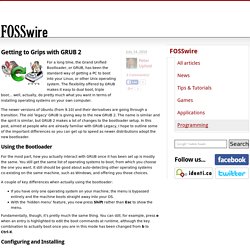
The flexibility offered by GRUB makes it easy to dual boot, triple boot… well, actually, do pretty much what you want in terms of installing operating systems on your own computer. The newer versions of Ubuntu (from 9.10) and their derivatives are going through a transition. The old ‘legacy’ GRUB is giving way to the new GRUB 2. The name is similar and the spirit is similar, but GRUB 2 makes a lot of changes to the bootloader setup.
In this post, aimed at people who are already familiar with GRUB Legacy, I hope to outline some of the important differences so you can get up to speed as newer distributions adopt the new bootloader. Using the Bootloader For the most part, how you actually interact with GRUB once it has been set up is mostly the same. 20 Top Most Used Common SSH Commands To Manage Unmanaged Server. As promised, I will teach babies* to manage unmanaged server from scratch.
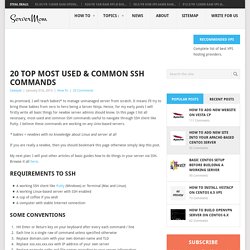
It means I’ll try to bring those babies from zero to hero being a Server Ninja. Hence, for my early posts I will firstly write all basic things for newbie server admins should know. In this page I list all necessary, most-used and common SSH commands useful to navigate through SSH client like Putty. I believe these commands are working on any Unix-based servers. * babies = newbies with no knowledge about Linux and server at all. Manpages(5) Mac OS X Developer Tools Manual Page. Mac Developer Library — Prerelease Developer Search Reporting Problems.

Example uses of the command mv. Quickly Show/Hide Hidden Files on Mac OS X Mavericks, Yosemite & El Capitan. It seems like every day I search Google for the command to show hidden files on Mac OS X, not to mention Googling for the command to then hide those hidden files a few minutes later.
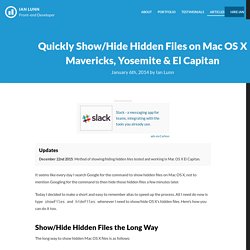
Today I decided to make a short and easy to remember alias to speed up the process. All I need do now is type showFiles and hideFiles whenever I need to show/hide OS X’s hidden files. Here’s how you can do it too. Manipulating Files with cat. Red Hat Enterprise Linux has a utility which can help you keep short lists, gather lists together, and even show you information about your system.
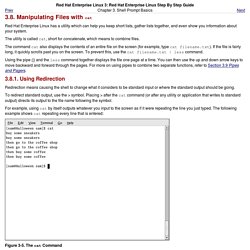
The utility is called cat, short for concatenate, which means to combine files. The command cat also displays the contents of an entire file on the screen (for example, type cat filename.txt). If the file is fairly long, it quickly scrolls past you on the screen. To prevent this, use the cat filename.txt | less command. Using the pipe (|) and the less command together displays the file one page at a time. 3.8.1. Redirection means causing the shell to change what it considers to be standard input or where the standard output should be going. To redirect standard output, use the > symbol. For example, using cat by itself outputs whatever you input to the screen as if it were repeating the line you just typed. Figure 3-5. Figure 3-6. Mkdir - create a directory.
Scripting - In a bash script, how can I exit the entire script if a certain condition occurs? HowTo: Check If a Directory Exists In a Shell Script. ByVivek GiteonApril 14, 2013 last updated August 23, 2013.

Shell script. HowTo Format Date For Display or Use In a Shell Script. ByVivek GiteonFebruary 27, 2007 last updated March 31, 2016.
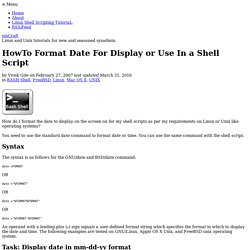
Print output to 3 separate columns. HowTo: Save The Output Of A Linux/Unix Command To A File. ByVivek GiteonFebruary 4, 2013 last updated February 4, 2014 I am new Linux and Unix-like system user who recently switched from MS-Windows XP.
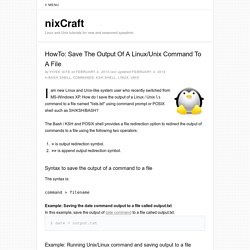
How do I save the output of a Linux / Unix ls command to a file named "lists.txt" using command prompt or POSIX shell such as SH/KSH/BASH? An A-Z Index of the Apple OS X command line. Commands marked • are bash built-in commands. bash is the default shell, it runs under Darwin the open source core of OS X.
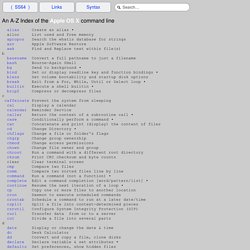
OS X Man Pages - Apple Developer ConnectionDiscussion forum Links to other Sites, Books etc... Working with Files and Directories. Here is an index to the topics in this section: The Unix filesystem structure All the stored information on a Unix computer is kept in a filesystem. Any time you initiate a shell login session, the shell considers you to be located somewhere within a filesystem. Although it may seem strange to be "located" somewhere in a computer's filesystem, the concept is not so different from real life.
After all, you can't just be, you have to be somewhere.
Touch. Rm. Find. Unix & Linux Forums.